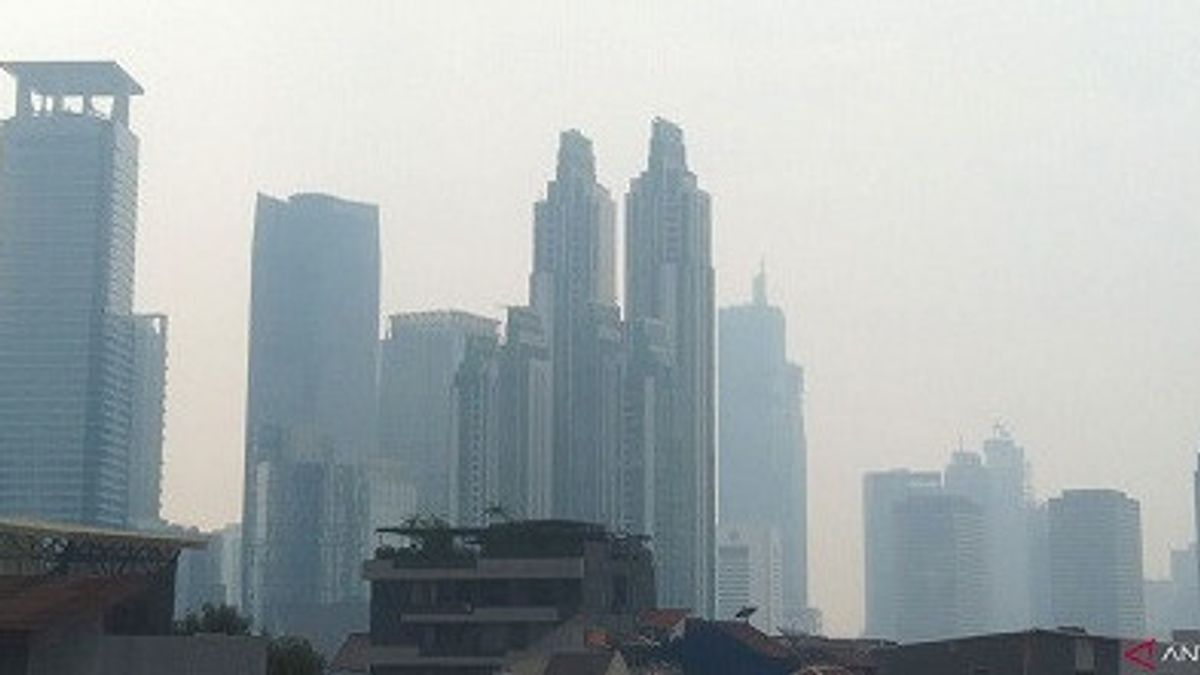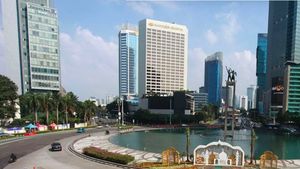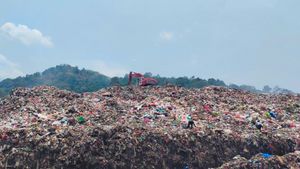JAKARTA - The government has allowed the public to take off their masks in open areas starting May 17, 2022, as positive cases of COVID-19 in the country continue to decline. However, the good news seems to still have to be put on hold. Especially for people in big cities, one of which is Jakarta and its surroundings.
The reason is that the air quality in the last few weeks in Jakarta has shown an unhealthy category so that it is dangerous for human health.
The air quality data agency, IQ Air, put Jakarta in the first position as the city with the worst or unhealthy air quality on Wednesday, June 15, 2022. IQ Air noted that the air quality index in the capital city at that time was 188 or categorized as unhealthy.
The category of unhealthy air quality is in the index range of 151 to 200 based on IQ Air. Meanwhile, the concentration of particulate matter (PM) 2.5 was recorded at 25.4 times above the World Health Organization (WHO) standard.
The unhealthy air quality even continued on Saturday, July 2, 2022 until 13:25 WIB, the air pollution index in Jakarta reached 166 and again occupied the first position of the worst air pollution in the world.
Underneath are New Delhi, India with an index of 165 and Tehran, Iran with an index of 154. Unhealthy air quality in Jakarta is not the first time this has happened.
At least IQ Air noted that Jakarta's air quality data in 2017 had increased by an average of 29.7 micrograms per cubic meter.
Then in 2018 it doubled to an average of 45.3 micrograms per cubic meter and in 2019 it rose to 49.4 micrograms per cubic meter.
The average air quality in Jakarta in 2020 then decreased to 39.6 micrograms per cubic meter in line with restrictions on community activities due to the COVID-19 pandemic.
What caused it?
The Meteorology, Climatology and Geophysics Agency (BMKG) revealed that the decline in air quality in the Jakarta area was due to a combination of emission sources from air pollution contributors and meteorological factors that caused the accumulation of PM2.5 concentrations.
PM2.5 is one of the air pollutants in the form of particles with a very small size, which is no more than 2.5 micrograms per cubic meter.
The results of monitoring PM2.5 concentrations by BMKG in Kemayoran, Jakarta showed a tendency to increase in the early morning to early morning and decrease in the afternoon to evening.
The threshold value (NAV) for PM2.5 concentration is 65 micrograms per cubic meter, below that value is between 15-65 micrograms per cubic meter, air pollution is at a moderate level and the concentration value is 0-15 micrograms per cubic meter. are in the good category.
Acting Deputy for Climatology at BMKG Urip Haryoko explained several factors that affect air pollution in Jakarta, namely emission sources, including local sources.
For example, transportation and residential, as well as from regional sources from industrial areas close to Jakarta.
These emissions under certain conditions are influenced by meteorological parameters, can accumulate and cause an increase in the concentration of PM 2.5.
Then, the process of movement of air pollutants such as PM2.5 is influenced by wind patterns that move from one location to another.
Furthermore, the BMKG noted that the increase in PM2.5 concentration has a directly proportional relationship with the water vapor content in the air which is expressed by the relative humidity parameter.
The high humidity of the air causes an increase in the absorption process which refers to the change of state from gas to particles. This process causes an increase in the concentration of PM2.5 which is facilitated by the water content in the air.
Another reason, BMKG noted that high relative humidity can cause an inversion layer to appear close to the surface.
The inversion layer is a layer in the air which is characterized by an increase in air temperature along with an increase in layer height.
The impact of the presence of an inversion layer causes PM2.5 on the surface to be trapped, unable to move to other air layers and results in the accumulation of its concentration which is measured in the monitoring tool.
In addition, there is stagnation in air movement which causes air pollutants to not move and impact on conditions that tend to last a long time.
Air stagnation conditions are characterized by low wind speeds which not only affect the accumulation of PM2.5, but can also trigger the production of other air pollutants such as surface ozone (O3), the presence of which can be indicated by a decrease in visibility.
The high humidity in the DKI Jakarta area is confirmed by BMKG data which shows the humidity range until Monday (4/7) reaches a maximum of 100 percent.
Life expectancy
With the very small size of PM 2.5 pollutant, the particles can easily enter the respiratory system and can cause respiratory tract infections and lung disorders in the long term.
In addition, PM2.5 can penetrate the circulatory network and be carried by the blood throughout the body which can cause cardiovascular disorders such as coronary heart disease.
This harmful impact on the health of the body also encourages international research institutions to conduct studies related to the life expectancy of citizens in big cities of the world, including Jakarta.
The Air Quality Life Index (AQLI) report developed by the Energy Policy Institute from the University of Chicago, United States released life expectancy figures related to the impact of air pollution.
Based on the latest global report in June 2022, AQLI revealed that air pollution, one of which in Jakarta, is driving its residents to lose three to four years of life expectancy in 2020.
"The most polluted areas in 2020 will be around the cities of Mandalay, Hanoi and Jakarta where people lose three to four years of life expectancy," the AQLI report said.
Even so, the report stated that Jakarta and the surrounding areas including Bogor, Depok, Bekasi and Tangerang (Jabodetabek), recorded that the annual average PM 2.5 concentration decreased by 16 percent in 2020 to 30.1 micrograms per cubic meter.
If the concentration of PM 2.5 can be permanently lowered, it is estimated that the potential life expectancy of around 29 million Jabodetabek residents could increase by 2.5 years in 2020.
Jakarta Effort
The Provincial Government (Pemprov) of DKI Jakarta has made various efforts to reduce air pollution in the capital city, including increasing the number of green open spaces.
DKI Jakarta Governor Anies Baswedan said that for more than three years, 296 city parks, 29 urban forests and 154 green lanes had been revitalized.
Support from the community is also needed by inviting them to use public transportation.
As a result, residents will walk more to the station or bus stop so that sidewalk facilities are also built and repaired.
Anies said that in less than four years of his administration, 341 kilometers of sidewalks had been built.
Not only that, during 2022 the DKI Provincial Government plans to build 195.6 kilometers of bicycle lanes from this year's target of 250 kilometers.
In line with Anies, Deputy Governor of DKI Jakarta Ahmad Riza Patria said for the pollution management program, his party is also making transportation improvements in DKI Jakarta including adding an electric bus fleet.
Currently, DKI Jakarta BUMD, TransJakarta have used a fleet of 30 electric buses and it is targeted that by the end of 2022 there will be 100 electric buses.
In addition, there is also a policy of reducing vehicles with an odd-even system and mandatory emission tests for motorized vehicles to imposing sanctions to revocation of permits for companies proven to have polluted the environment.
Cross region
Handling air pollution is actually not a matter for DKI Jakarta alone, but has crossed regions.
Environmental non-governmental organizations (NGOs) who are members of the Capital City Coalition say that air pollution in Jakarta is a cross-border problem that must be controlled more quickly together.
Head of the Pollution and Environmental Damage Control Division of the Indonesian Center for Environmental Law (ICEL) Fajri Fadhillah said the sources of air pollution from outside Jakarta, especially from industry and coal-fired power plants.
In such conditions, he continued, the Minister of Environment and Forestry (LHK) must carry out its obligations to supervise and supervise the Governors of Banten, West Java and DKI Jakarta.
The supervision and supervision is to make efforts to tighten the emission threshold for all sources of air pollution in their respective regions.
He asked that emission quality standards for both motorized vehicles and industries such as fossil-powered power plants should be tightened.
In line with Fajri, Greenpeace Indonesia's Climate and Energy campaigner, Bondan Andriyanu assessed that the main cause of air pollution is that there are still sources of air pollution, both moving and immovable.
He assessed that the pollutant source was proven to have not been maximally controlled through policies that should have been taken by the government. The reality is that currently air pollution is still happening in Jakarta and its surroundings.
For this reason, the Head of the DKI Jakarta Environmental Service, Asep Kuswanto, invited the residents of the capital to use masks, especially when they are outside the room/home to anticipate air pollution.
"Even if you have to leave the house, always use a mask because the air quality in Jakarta is not good," said Asep Kuswanto.
The English, Chinese, Japanese, Arabic, and French versions are automatically generated by the AI. So there may still be inaccuracies in translating, please always see Indonesian as our main language. (system supported by DigitalSiber.id)













